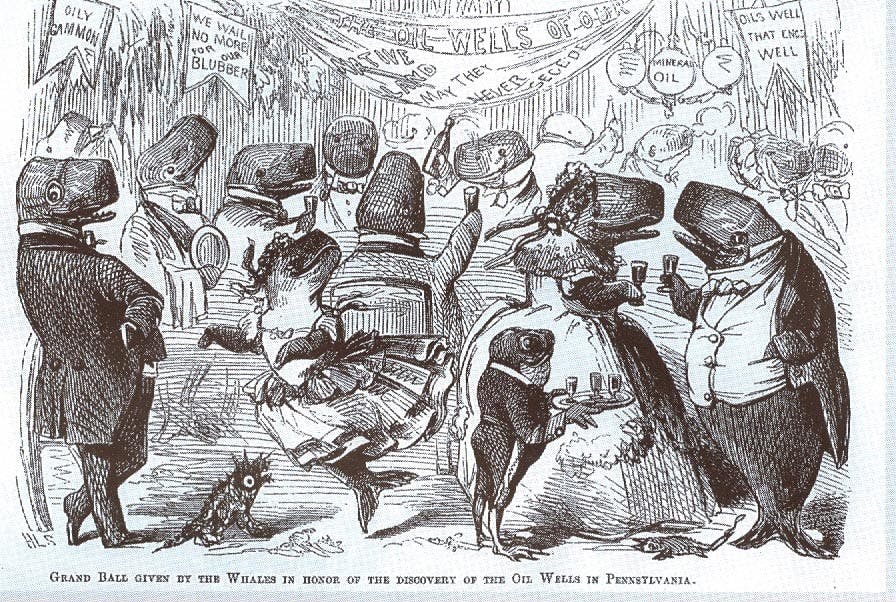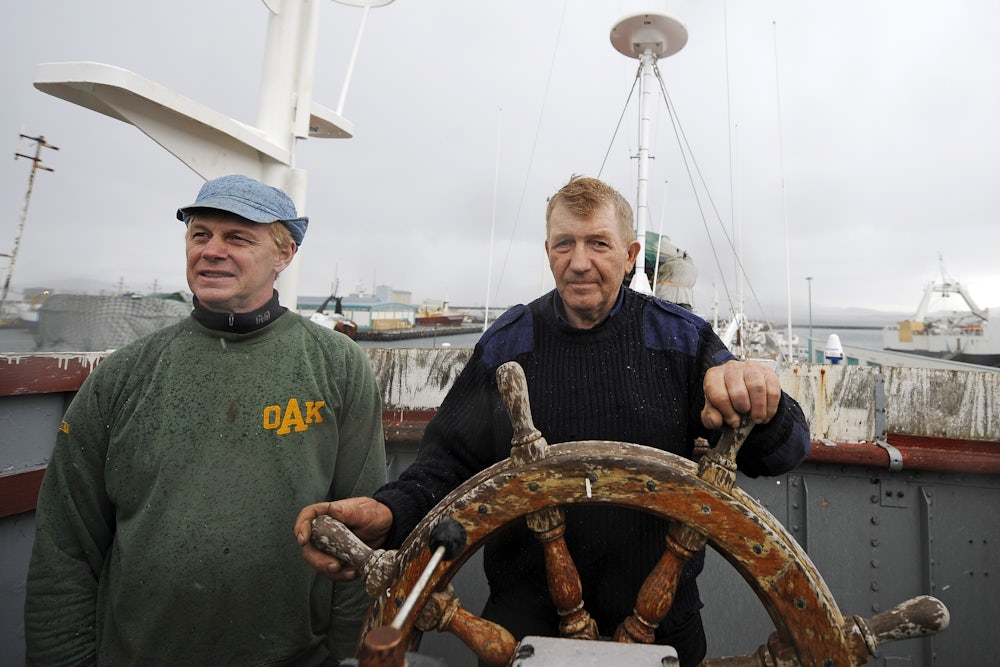With 400,000 dead from Covid-19 and the nation still reeling from the raid on the U.S. Capitol, an odd corner of the internet has emerged to provide temporary comfort and distraction in the past few weeks: sea shanty TikTok. The flashpoint was a video from Scottish singer and postal worker Nathan Evans performing “Wellerman,” a nineteenth-century New Zealand folk song recounting the harrowing journey of a whaling ship. True to form—shanties are catchy, collaborative tunes, whose rhythm is used to help coordinate labor among the men on seafaring vessels—other creators piled on, posting their own variations to TikTok, adding bass lines, violins, and Kermit the Frog. “One day, when the tonguing is done,” one line broods, “We’ll take our leave and go.”
While the idea of killing a whale at sea and scooping literal tons of fat from its carcass seems violent and antiquated today, commercial whaling was big business through much of the eighteenth and nineteenth centuries and beyond, with whale oil helping to grease, supply, and fuel everything from factories to high fashion to the transatlantic slave trade. The cause of the industry’s demise has long been a contested subject among energy experts. Ideologues peddling the “whale oil myth” highlight petroleum and the free market as the great savior of majestic sea creatures. They point to the 1861 discovery of cheaper, less labor-intensive petroleum in Western Pennsylvania as the main reason the world stopped using whale oil to turn on the lights.
It’s called a myth for a reason. And the whale oil myth can, in turn, say a lot about today’s myths regarding what it’ll take to get off fossil fuels. Optimists have long pointed to the precipitously falling price of renewables as evidence that they’ll soon outcompete fossil fuels, as consumers rationally sub out their gas lines and internal combustion vehicles for greener alternatives. So far, though, ever-cheaper wind and solar has mostly added to the global energy mix, not driven out its competitors at a pace that inspires much hope. “The idea that the development of a new resource will suppress use of a formerly dominant resource is at least as common today as it was in the past—that is, just as some people expected the rise of fossil fuels to suppress whaling in the nineteenth century, the development of nonfossil energy is expected by many to suppress fossil fuel use in the twenty-first,” University of Oregon economist Richard York wrote in a 2017 paper. The proliferation of fossil fuels, he notes, was in fact instrumental in developing modernized whaling techniques, from powered ships to harpoon cannons.
Early whaling in North America orbited around Nantucket and, later, New Bedford, Massachusetts. Especially after technological innovations allowed custom-built whaling ships to render fat into oil onboard, whaling became a critical source of revenue for the Crown, to the point where Nantucket considered opting out of the Revolutionary War given its trade with England. “They weren’t selling a lot of whale oil in the colonies. Almost all of it went to London and the Caribbean, where they would use oil for rendering sugar,” environmental historian Jeremy Zallen, author of a history of artificial lighting, American Lucifers, told me. The oil itself was an important product, used both in lighting and as a lubricant in various industrial processes. So were high-quality spermaceti candles, which slavers would trade for people in West Africa and the Caribbean. After England and the United States officially outlawed the import of enslaved people, many converted whaling vessels were used to keep it going under the radar. As Zallen explained, these “floating factories” were unique in that they billowed smoke, something ordinarily only spotted on vessels—often slave ships—that cooked large amounts of food. “Ships that had all this smoke coming up meant that you were either cooking a lot of food for a ton of people or you were trying out the whale oil” in onboard facilities known as tryworks. Slavers manning converted whaling vessels, he said, “could plausibly claim, ‘We’re not cooking food,’” and make use of the large hulls built to store oil.
Although whaling was bound up in the slave trade, whaling crews themselves were relatively diverse, Zallen said, and—as in other maritime professions—almost exclusively male, features which were both dramatized in Moby Dick. Quakers dominated the whaling industries in Nantucket and New Bedford and were more likely to be abolitionists. And being away at sea was an attractive option for enslaved people trying to escape. Rather than being paid in wages, crew members made a cut of the profits from whatever whales they caught, with the lowest-ranking workers getting the smallest share of the haul. Voyages could last for months at a time.
As it became harder and harder to find whales in the Northeast amid population declines, ships sailed south, eventually rounding the continent and coming up all the way through to the Pacific. Desertions were common en route, as crewmen would stop off at hubs like Hawaii and Chile, either to seek land-based employment or to join up with new and hopefully more profitable ships. Environmental historian Bathsheba Demuth’s book Floating Coast tracks the evolution of whaling in the Bering Strait, where Atlantic whalers landed in the mid-nineteenth century. The Iñupiat and Yupik there, she explains, have hunted whales for subsistence in the Arctic Circle for thousands of years, utilizing them for everything from food to housing in an environment where the climate has made large-scale agriculture basically impossible.
“The only thing that Indigenous whaling and commercial whaling have in common is that they kill whales,” she said. “The dividing line between subject and objects—understanding animals as fundamentally separate—is not operative” in Indigenous whaling, she told me, where bowhead whales hunted for subsistence are understood “as constitutive of human social worlds. That’s very different from understanding whales as a commodity.… Commercial whalers really could only use the fat,” carried as blubber along the outside of the animal. “Whalers would strip that out. The rest was waste material, left to float for sharks.” Reconstructed numbers indicate that Indigenous whalers killed roughly 100 bowhead whales a year around the advent of commercial whaling in the Bering Strait, out of a population of 20,000 bowhead whales. Commercial ships routinely harvested hundreds or thousands in a single season.
By the time petroleum was entering the market via a different kind of extraction, only the wealthy were using whale oil to light their homes. It didn’t give off the harsh smells that burning animal lard and tallow did and burned cleaner than kerosene (then typically coal-derived oil) and camphene, a cheap but highly combustible mixture of turpentine and alcohol. But whale “bones” (baleen) continued to be used for producing corsets, which was the case until the invention of spring steel in 1907 and as the binds fell out of fashion. Maritime industries in Norway and Japan began using steam-powered ships and high-caliber harpoons for more prolific hunting around the world. Blubber became an important ingredient for industrial food products like margarine. Whale oil continued to be a helpful and hard-to-replace lubricant in many industrial processes, as well. “The phrase energy transition gives you this sense that, one day, petroleum arrives and the previous sources of fuel are gone,” Demuth told me. “But there’s lots of path dependency in how you light your house.”

Whales became scarce. Whaling interests, Zallen said, were “invested in the idea that there aren’t fewer whales, that they were just becoming harder to find. They were invested in this idea that there wasn’t scarcity.” But this illusion became harder to maintain. More brutally efficient methods kept rapidly driving down whale populations until the first quotas were imposed by the International Whaling Commission after World War II. Unlike many sites of fossil fuel extraction, New Bedford and Nantucket were generally wealthy, home to built-out industrial bases and well-off financiers. The latter, especially, transitioned easily into new ventures (especially, in New England, textiles). Crew members would look to get involved in land-based work, eager to avoid the drudgery of whaling life, or find new maritime work in merchant marine fleets or the Navy.
But the end of whaling looked very different in the Bering Strait. Whaling hadn’t built up any big cities there. And what might have been a breath of fresh air for Indigenous whalers amid the decline of commercial missions was anything but. “The exit of the presence of whalers at a large scale happens more or less simultaneously with the arrival of the colonial state at scale,” Demuth said, including settlers from both Russia and the U.S. “People have described whaling to me like the first oil rush. ‘We went through one of these when the whalers came, but then there was just another sequence of these disruptive social and ecological events,’” from the Gold Rush to oil.
While drilling had been happening in the area since 1902, the discovery of oil on the Kenai Peninsula in 1957, Alaska’s first governor said, provided the “economic justification for statehood.” Companies like Shell, Chevron, and Texaco flocked north, soon finding gas and new oil reserves that sparked a boom in both fossil fuel infrastructure and settler populations. “All of the people who came up here in the early ’50s probably came up here for homesteading,” one oil company employee told the local Peninsula Clarion in 2017.
That extractive colonial legacy is now coming back with a vengeance in the form of global warming. Northern Alaska is one of the fastest-warming places on Earth. The decline of sea ice threatens the livelihoods of the Iñupiat and Yupik—while making it easier for companies to ship products through the narrow Bering Strait as the world warms. “Bowheads have been hunted, but they haven’t had to contend with large-scale motorized traffic. Neither have walruses and seals. All of these marine mammal populations sing to each other all the time underwater,” Demuth told me. Already, North Atlantic right whales are “going extinct in real time” thanks to ship strikes and entanglements with commercial trawlers. “We’re not killing whales for the commercial market but could be killing them with the commercial market.”
Contra the whale oil myth, the advent of oil didn’t save the whales so much as open up new avenues for them to die. The end of whaling was a long, slow process driven as much by destructive over-hunting as the new possibilities of petroleum. And the transition on its own did little to alleviate the trade’s most destructive impacts on ocean ecosystems and Indigenous livelihoods. The International Whaling Commission finally voted to ban commercial whaling in 1982, in the hopes of reviving beleaguered populations. Ironically, Richard York points out, the prospect of regulations increased whaling through the twentieth century. As restrictions from the IWC looked likely, he writes, “whalers, who had fixed capital investments in their whaling ships and other apparatus, had an extra incentive to catch as many whales as possible before laws restricted their capacity to do so.”
Free-market boosters today see the whale-to-petroleum shift as proof that energy transitions can be the quick and easy product of benevolent market forces, suggesting the same might be true with renewables seamlessly substituting for fossil fuels once they become cheap enough. (No need, in other words, to phase out fossil fuels as a matter of policy.) It’s an analogy that misunderstands both history and the present.
The Invisible Hand is not winding down the fossil fuel industry at nearly the pace the planet requires. Its executives see the writing on the wall, and—like whalers before them—may yet ramp up production as new climate rules come into sharper focus. Whether in the form of petrochemical facilities or fracking, the fossil fuel industry is actively finding new frontiers and technologies to keep business as usual humming along, however much they talk up their climate commitments. The question now is whether individual countries and the international community will step in quickly to stop them and make fossil fuel extraction look as anachronistic and grotesque 100 years from now as commercial whaling does today. There are already plenty of good songs about it to feed viral trends.








